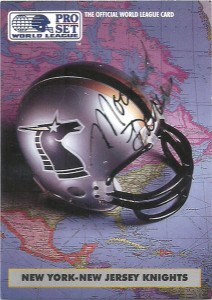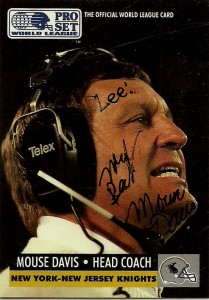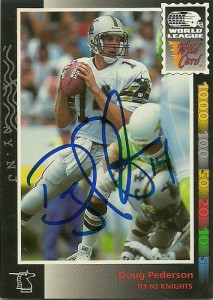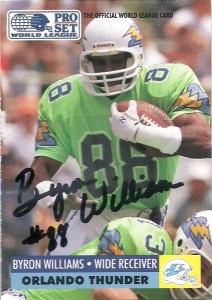 Cards: ProSet WLAF 1991 LL, ProSet WLAF 1991, ProSet WLAF TC 1991, Ultimate WLAF 1992, Wild Card WLAF 1992
Cards: ProSet WLAF 1991 LL, ProSet WLAF 1991, ProSet WLAF TC 1991, Ultimate WLAF 1992, Wild Card WLAF 1992
Acquired: TTM 2011, C/o Work
Sent: 4/8 Received: 4/14 (6 days)
Byron Williams is a player I’ve been trying to track down since the beginning of this insane project, so I was really happy to locate him and get in touch with him via email about signing these cards. In the end it worked out really nicely, as he signed these cards in a short 6 days. He also included information about his football camps “The Timeout Guys”.
After being taken out of Texas-Arlington in the 10th round of the 1983 draft by the Green Bay Packers, Byron would see time on the roster of the Eagles before finally getting some playing time with the New York Giants that season. (Incredibly fast, Williams ran a 4.23 40 and 10.13 in the 100 during college.) Playing in 5 games he’d make 20 catches for 346 yards and a touchdown his rookie season. In his sophomore campaign he’d make 24 receptions for 471 yards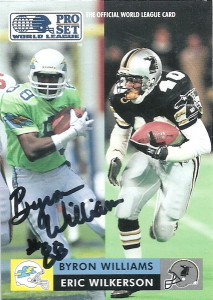 and 2 touchdowns, averaging a sizzling 19.6 yards a reception including a 65 yard grab. In the season opener against the Eagles he pulled down a career high 5 catches for 167 yards and a touchdown to help the Giants win 28-27. Given the opportunity to start 5 games in 1985, Williams would make 15 receptions for 280 yards.
and 2 touchdowns, averaging a sizzling 19.6 yards a reception including a 65 yard grab. In the season opener against the Eagles he pulled down a career high 5 catches for 167 yards and a touchdown to help the Giants win 28-27. Given the opportunity to start 5 games in 1985, Williams would make 15 receptions for 280 yards.
He’d head North in 1987 to the CFL and play for the British Columbia Lions and the Ottawa Rough Riders in 1989.
Byron Williams would be drafted in the 3rd round of the supplemental draft by the Orlando Thunder of the WLAF in 1991. At 6’1″, 178, Byron provided a big and fast veteran target for quarterback Kerwin Bell in the spread/ run ‘n shoot offense of the Orlando Thunder. Byron would also provide a barometer of leadership for the team,- at 30 he was one of the oldest players in the league.
He’d split the scoring title in 1991 with Eric Wilkerson (Knights) after he made 11 touchdown receptions on the season. I remember the league season opener when he made 3 touchdown grabs against a beleaguered San Antonio secondary. He’d end up with 113 yards on 4 catches, with touchdown grabs of 23, 37, and 42 in the Thunder’s 35-34 win. Williams would make also 2 touchdown receptions against the Skyhawks the next week and the Machine in the final game of the season. Byron in fact was the primary beneficiary of quarterback Kerwin Bell’s touchdown passes and finished second in the league in receiving yardage with 811 yards in 1991 after scoring in 7 out of 10 games. He’d be named to first team All-World Honors following the season.
after he made 11 touchdown receptions on the season. I remember the league season opener when he made 3 touchdown grabs against a beleaguered San Antonio secondary. He’d end up with 113 yards on 4 catches, with touchdown grabs of 23, 37, and 42 in the Thunder’s 35-34 win. Williams would make also 2 touchdown receptions against the Skyhawks the next week and the Machine in the final game of the season. Byron in fact was the primary beneficiary of quarterback Kerwin Bell’s touchdown passes and finished second in the league in receiving yardage with 811 yards in 1991 after scoring in 7 out of 10 games. He’d be named to first team All-World Honors following the season.
He’d return to the CFL after the 1991 season and play for the Saskatchewan Roughriders from 1991-1993, but playing his 1992 summer in the WLAF. Byron, like Stan Gelbaugh would be involved in a dispute over contract rights between the World League and the CFL /NFL (,much like the one involving the fees the UFL is requiring the NFL to pay for the conditional release of a player).
 The Thunder meanwhile would stock up on wide receivers in the off season and trade Williams to the New York New Jersey Knights. In limited action Byron would grab 11 receptions for 166 yards and a touchdown before the WLAF reorganized after the 1992 season. In the meantime Byron would play 1993 with the Roughriders.
The Thunder meanwhile would stock up on wide receivers in the off season and trade Williams to the New York New Jersey Knights. In limited action Byron would grab 11 receptions for 166 yards and a touchdown before the WLAF reorganized after the 1992 season. In the meantime Byron would play 1993 with the Roughriders.
In 1994 CFL expanded southward into the United states. Byron would sign with the Baltimore Colts that season and play through 1995 earning a Grey Cup championship and retiring after the season.
Byron has remained active in football, running his own business (BW Sports, TimeOut Guys) and is a big proponent of giving back through teaching and coaching young fans and athletes in football. Williams’ camps are considered amongst the elite for training young athletes and they not only provide training but venues for young athletes and fans to meet former and current players. Byron has also spent time working with the American Youth Football organization and gives an immense amount of time to charity. Below are his WLAF statistics.
G/Gs N/a Rec 70 Yds 977 Avg 14.0 Td 12 Lg 46t
